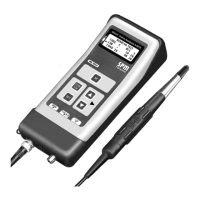48
Technical data are subject to change without notice.
ISO 9001 certified. © Copyright SPM 1996-9. 71411.B
SPM Instrument AB • Box 4 • S-645 21 Strängnäs • Sweden
Tel +46 152 22500 • Fax +46 152 15075 • info@spminstrument.se • www.spminstrument.se
Typical Shock Pulse Patterns from Rolling Bearings
Fig. 27
Fig. 28
Fig. 29
A shock pulse pattern is a sequence of either random
or rhythmical strong pulses (peaks) above a carpet of
very rapid weaker pulses (HR level). The LR reading
represents a level where the intrument registeres
about 50 strong pulses a second. With the earphone
you can establish whether there are individual, stronger
pulses above that level.
With the earphone you can also discern the rhythm of
the strongest pulses. Typical for bearing signals is a
random sequence of strong pulses (no discernable
rhythm). Rhythmical shocks can come from a bearing
but are more often a sign of interference. Typical
patterns are described on the next pages.
Note that some patterns can have more than one
cause. The examples on pages 50 and 52 describe
how to distinguish between possible causes.
Pattern from a Good Bearing
A bearing in good condition should have CODE A
and a delta value of about 4 (fig. 28). Once you have
verified the reading, there is no need for any further
evaluation.
LR/HR values can be lower than 0. However, be suspi-
cious when the measured value is very low. The cause
is often a bad measuring point or an incorrectly in-
stalled adapter or transducer. Check with LUBMASTER
and set a COMP No.
Note: If the reading is very low, check the installation.
Measure on other parts of the bearing housing and
try to pick up a stronger signal. Another possible
reason for a very low reading is that there is no load
on the bearing. This can happen with well balanced
fans and similar rotating machines.
First Signs of Damage
CODE C and rising LR/HR readings are a sign of
stress in the bearing surfaces or minor damage. Note
that the delta value gets larger.
Bearings with CODE C should be measured more
frequently, to determine if their condition is stable or
deteriorating. Watch the trend of the COND No.
1. Peaks
2. Difference peaks and HR level
3. Rhythm of the strongest pulses

